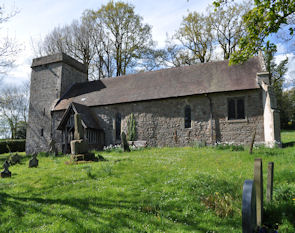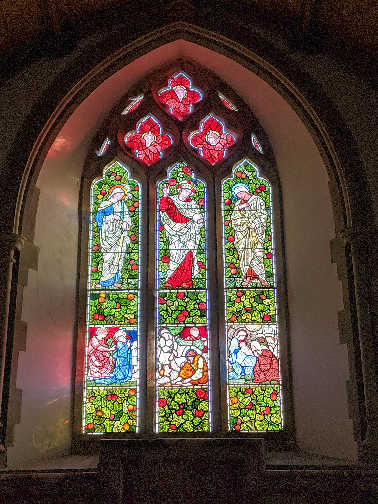St Mary’s Church sits on a high bank above the village of Whitton in Shropshire. It is hidden from immediate view, being surrounded by mature trees and hedging.
The main access is via a set of steps from a sunken lane, then on through a gate into the churchyard. Much of the structure dates from the 12th Century and the Norman origins are still visible in the slit windows and the south doorway, which is unusual in that the arch and tympanum stand, as it were, on their own with no attempts to link them up with the pillars, and is a rare example of the stage between the plain Norman arch and the dog tooth. At the West end stands the massive and squat tower, unrelieved by any stages. Here, as also in the Nave structure, can be seen thin Roman bricks, possibly salvaged from a Roman Villa in the neighbourhood. The main fabric is of local stone with a simple oak beam roof supporting clay tiles. In the early 1890’s some extensive alterations were made, comprising the rebuilding and extending of the Chancel at the East end, the erection of a vestry and organ chamber and the insertion of various windows.
There is a second access to the Church via a grass and rubble driveway to the north.
The interior furnishings are on the whole simple with gentle and sympathetic carving to the pulpit and choir stalls, as befits a small country church of this type.
On entering one notices a blocked-up doorway opposite in the North wall. A possible explanation is that in some parts of England, during the middle ages, it was the custom to carry children in for baptism through the North door, which was slammed shut as soon as the baptism was performed. The North side was looked on as the “Devil’s Side” and in this way signified “Death unto Sin and New Birth into Righteousness”.
In the base of the tower is a Baptistry with a mainly Norman font with Victorian renovations. It is unusual to have a font in its own Baptistry rather than just inside the door.
Further up the North wall can be seen a carved chalice set in the stone; this was originally on the grave of a priest and is now placed near to where the altar formerly stood. In the Nave are three of the original Norman windows. A larger 14th Century window is in the South East corner with a piscina in the West splay. This window would almost certainly have had a twin opposite and formed the altar and chancel before the extension in Victorian times.
The East window (photograph right) is an excellent example of Pre-Raphaelite art during the last twenty years of the 19th century. The design is the work of Sir Edward Burn-Jones, as was executed by William Morris. For those interested in seeing more works by Burn-Jones,
All Saints Church in Wilden, Worcester houses fourteen windows of his design. Further afield, a large number of Burn-Jones drawings and paintings can be viewed at
Wightwick Manor in Wolverhampton.
The churchyard is looked after under the under the 'Caring for God's Acre' scheme, mainly by volunteers, with conservation management being most important and during spring there is an abundance of wild flowers, principally wild daffodils.
For Services
Go Here...
|

 |


